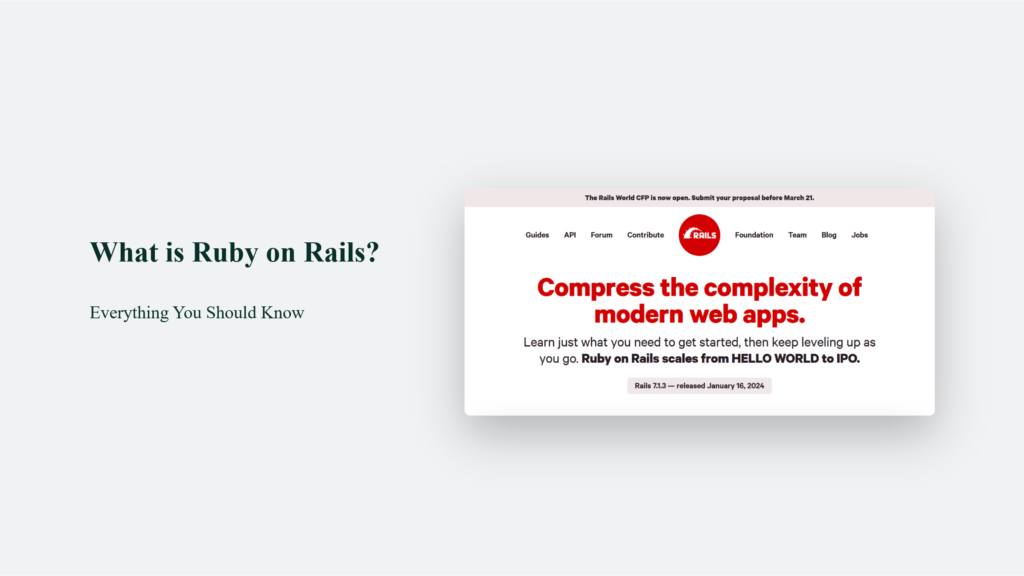In a digital era defined by the pursuit of sleek, efficient web applications, a pioneering framework emerges as the architect behind the scenes, weaving the complex tapestry of the internet with precision and ease.
This tool, beloved by developers for its elegance and power, is the cornerstone for countless success stories across the web. So, let’s find out more about this and learn what is Ruby on Rails?

Key Takeaways
- Rails is a full-stack framework emphasizing rapid development and clean, maintainable code.
- It supports the MVC architecture, facilitating a well-organized codebase.
- The Rails ecosystem is vast, offering solutions (gems) for virtually any application feature.
- Rails is a popular choice for web application development thanks to its efficiency and scalability.
What is Ruby on Rails?
Ruby on Rails, often simply referred to as Rails, is more than just a web application framework. It’s a full-stack, open-source software marvel that enables developers to craft beautiful, robust web applications easily and precisely. Built on the Ruby programming language, Rails embodies the principles of rapid development, offering a rich tapestry of features that cater to startups and established enterprises.
The Birth and Evolution of Rails
The story of Ruby on Rails, commonly known as Rails, is a fascinating chapter in the annals of web development. This journey commenced in 2004, with David Heinemeier Hansson at the helm, releasing Rails as an open-source project. This bold move was inspired by his work on Basecamp, a project management tool that underscored the framework’s potential for rapid, efficient web application development.
Rails was born out of a need to simplify web development’s complex, often tedious processes. By introducing conventions that automatically handle routine tasks, Rails empowered developers to focus on unique features rather than getting bogged down by boilerplate code. Encapsulated by the mantra “Convention over Configuration,” this philosophy has been a guiding light for Rails development over the years.
From its inception, Rails has championed the Model-View-Controller (MVC) architecture, which organizes application programming through a clear separation of concerns. This architectural pattern and Ruby’s expressive syntax made Rails an instant hit among developers looking for an efficient, readable, and maintainable approach to web development.
Over the years, Rails has seen numerous versions, each adding new features, enhancing performance, and expanding its ecosystem.
Introducing features like Active Record for database interactions, Action Pack for controller and view layers, and Active Job for background jobs, among others, has continually improved Rails’ robustness and versatility.
Significant milestones in Rails’ evolution include the introduction of major releases like Rails 2, which brought RESTful resources into the mainstream; Rails 3, which merged Rails with the Merb framework to enhance performance and modularity; Rails 4, which introduced strong parameters and improved caching; and Rails 5, which brought Action Cable for real-time features and API mode for building APIs more efficiently.
The release of Rails 6 continued this tradition of innovation, introducing multiple databases support, parallel testing, and Webpacker by default for JavaScript management, showcasing Rails’ adaptability to modern web development trends.
As of January 2024, the latest version, Rails 7.1.3, marks the current pinnacle of its evolution, reflecting Rails’ ongoing commitment to facilitating web development that’s both powerful and pleasurable. Like its predecessors, this version underscores the Rails community’s dedication to enhancing the framework’s performance, scalability, and developer-friendly features.
The evolution of Rails is not just a story of software development; it’s a testament to a vibrant community’s ability to adapt, innovate, and foster an environment where developers can thrive. As Rails continues to evolve, it remains a cornerstone of modern web development, embodying the principles of efficiency, elegance, and expressiveness that have made it a beloved framework for nearly two decades.
Rails: The MVP’s Best Friend
Imagine having a toolbox where every tool is meticulously designed to fit perfectly in your hands, ready to solve any problem with a few deft strokes. That’s Rails for you. It’s the go-to choice for startups and large enterprises alike, thanks to its “convention over configuration” mantra. This philosophy streamlines development, allowing you to focus on unique application features rather than boilerplate code.

Key Features and Advantages
- Full-Stack Framework: Rails provides a seamless experience for front-end and back-end development, boasting tools and libraries covering everything from database interactions to web page styling.
- MVC Architecture: It employs the Model-View-Controller (MVC) pattern, promoting clean, maintainable code by separating concerns.
- Rich Ecosystem: The Rails community has produced a vast collection of “gems” (libraries) that extend its functionality, covering almost any feature a web application might need.
- Rapid Development: Rails’ emphasis on DRY (Don’t Repeat Yourself) principles and convention over configuration accelerates development, making it ideal for MVPs and rapid prototyping
Who Uses Rails?
The Ruby on Rails framework, affectionately known as Rails, has powered the infrastructure behind some of the most influential and widely used applications on the internet. Among its early adopters, Twitter stands out as a prime example, leveraging Rails’ capabilities to handle the complexities of social media interaction and rapid scaling during its formative years.
Another testament to Rails’ robustness and adaptability is Shopify, an e-commerce behemoth that relies on Rails for its core platform. This choice underscores Rails’ ability to efficiently manage extensive inventories, complex transactions, and high traffic volumes.
The adoption of Rails extends beyond these giants, encompassing a variety of sectors, including entertainment, technology, and services. Companies like Hulu, a streaming service giant, and GitHub, the renowned software development platform, have also built their platforms on Rails. This broad application across different industries highlights Rails’ versatility, proving it an asset for startups and established companies aiming for scalability, rapid development, and maintaining a competitive edge in the digital landscape.
Is Rails Right for You?
Deciding whether Ruby on Rails (Rails) is the right framework for your project involves considering several key factors. At its core, Rails is renowned for accelerating the development process, thanks to its “convention over configuration” philosophy, which minimizes the setup time for new projects and streamlines decision-making.
It makes Rails an excellent choice for startups and businesses looking to quickly move from concept to launch, ensuring a faster time-to-market for new ideas.
Ease of use is another significant advantage of Rails.
It offers a straightforward development process, making it accessible for new developers while still powerful enough for experienced programmers. The framework’s vast ecosystem of “gems” — libraries that extend functionality — means that developers can easily add features and functionalities to their applications without building everything from scratch.
However, choosing Rails also depends on your team’s familiarity with the Ruby programming language and willingness to adopt the Rails conventions. If your team values rapid development, embraces convention over configuration, and the project requirements align with Rails’ capabilities, then Rails could be an excellent fit for your next web application project.
Ultimately, the decision to use Rails should be based on a combination of project requirements, team expertise, and the advantages Rails offers, such as speed, efficiency, and a supportive developer community.
Frequently Asked Questions:
What makes Rails different from other frameworks?
Rails is known for its “convention over configuration” approach, which reduces the amount of setup and decision-making developers have to do, speeding up the development process.
Do I need to learn Ruby before starting with Rails?
Can Rails scale to meet high-traffic demands?
Absolutely. Many high-profile companies, including Shopify and Airbnb, use Rails to handle millions of users. Scalability often depends more on the application architecture and database design than on the framework itself




